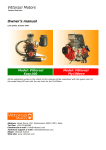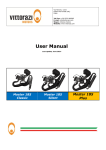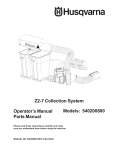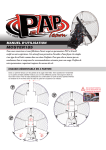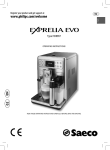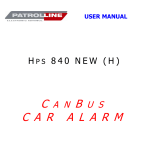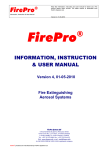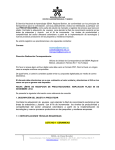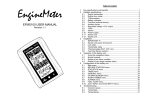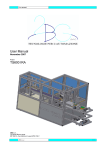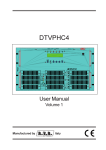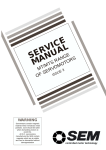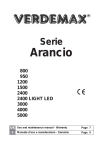Download Vittorazi Moster 185
Transcript
Vittorazi Motors Passion lives here Owner’s manual Last update, May 2011 Model: Vittorazi Moster 185 Registered office: via Roma, 182. Montecosaro 62010 (MC). Italia Headquarter: via Marche 1. Morrovalle 62010 (MC). Italia Tel/Fax: +39733 866585 E-mail address: [email protected] Technical e-mail address: [email protected] Skype: vittorazi.motors Web site: http://www.vittorazi.com Index 1.0 2.0 3.0 Introduction Warning Installation engine components 3.1 3.2 3.3 3.4 3.5 3.6 3.7 3.8 3.9 3.10 4.0 Get ready for the use 4.1 4.2 4.3 4.4 4.5 4.6 4.7 5.0 6.0 Ignition coil and spark-plug Check and cleaning carburetor Reed valve Gaskets Exhaust silencer Rubber mountings Pull starter Moster185 Reduction drive Moster185 Piston, cylinder, head Crankshaft, crankcase and bearings Flywheel and ignition timing Charts of maintenance Tightening torque and special tools Spare parts Frequent asked questions - FAQ Warranty 11.1 11.2 11.3 11.4 12.0 Propeller choice and mounting Fuel Starting and turning off Warm-up Carburetor adjustment Break-in First check-up Specifications and technical data Maintenance 6.1 6.2 6.3 6.4 6.5 6.6 6.7 6.8 6.9 6.10 6.11 7.0 8.0 9.0 10.0 11.0 Exhaust pipe Rubber mountings Air-box Ignition coil and spark-plug Electric installation Gasoline tank and pipe Throttle controller Pull starter Moster185 Choice of propeller Accessories Warranty registration Limited warranty Warranty coverage Warranty coupon Contacts 2 1.0 Introduction Thanks for choosing a Vittorazi engine product. The user manual constitutes integral part of the motor, it has to be preserved and combined to the motor in case it will be delivered to a new user. Before installing of the motor, read this manual carefully. The purpose of this manual is to provide the user with all the information he needs to manage the engine properly by himself and in the safest possible way. It includes information about the technical aspect, operation, machine stop, maintenance, spare-parts and safety. If just one parts of the manual is not completely understood or in case the manual is not clear or exhaustive, do not hesitate to contact either the authorized dealer or our factory for any problem or question you might have. Please include in the claim the serial number XXXX of the motor that you find under the system carburetor, some photos if you think it is necessary. You find the direct contacts of the factory in the first and in the last page of this manual. The Vittorazi reserves the right to change in any moment without warning, sketches, specifications, component, details of the motor, in relation to the model in production without incurring in any obligation. When you receive the motor, it will already have overcome a test of 15 minutes in the factory, verifying the operation of all the components and the operation to every speed. All Vittorazi engines are tested before the delivery. The reliability, the performances and the duration of your motor will also depend from your knowledge and the way you use it. In this manual will be underlined: in the red panel the situations that can lead you to a serious danger; in the blue panel, important suggestions or advice that must not be underestimated. Attention, danger, risk Important advice, suggestion In the present photos/picture of this manual: the arrows of green colour will have generic indications specified in the inherent paragraphs; the arrows of blue colour will indicate to add thread locker medium strength; the arrows of brown colour will indicate to add some grease; the arrows of black colour will indicate to add sealing paste, resistant to high temperatures (up to 500-600°C). 3 2.0 Warning • Be aware that the motor can stop, have a breakup or to go off in any moment. This could lead a crash to the ground or a landing in hostile areas with possible damages/death of the pilot or other people. The ultralight moved by this motor must fly in permitted spaces, it must not fly above a crowd of people, inhabited centers, zones that have difficult or void landings, must not fly above zones of water or where it is possible to drown. Always have in mind that the motor can go off or breakup, therefore consider a possible landing of emergency for every situation. • This manual describes the motor. For its installation, use and control, compare also the attached user manual of the ultralight: Paramotor, Mosquito or Trike. If used in other applications, cannot be guaranteed the correct operation. • This motor is not certified. It is not a motor with guarantees or aeronautical certifications. Its construction is destined to experimental and not certified aircrafts. • Some zones for particular atmospheric conditions as pressure, temperature, damp can bring to a different operation of your motor. Before beginning every flight, you test the motor on the ground and verify that it doesn't have an anomalous behavior. • Start the engine in a plain surface, free from stones, sand or small parts that could be aspirated by the propeller. Be sure that the flow of air pushed by the propeller doesn’t cuase damage to anybody. Whenever the motor is running (testing on the ground, take-off, landing) watch out that nobody stands near to the propeller in rotation. A good safety distance is 50 meters for all directions of projection of the propeller and 20 meters for the others directions. • Do not use the motor that has not followed a correct maintenance or has not correctly been used in the time or if you know that is not under perfect conditions. • The use of non original spare-part and not recognized by Vittorazi, can make the motor dangerous and immediately hands term to the validity of the warranty. Vittorazi doesn't assume any warranty for that motor that are used with non original parts or not recognized, modified or that have had an improper use. • Unauthorized changes to the motor, to the reduction, to the propellers can reduce safety and reliability of the aircraft. In case you have to intervene on the motor we invite you to compare this manual with the help of your dealer Vittorazi and follow it as reference. • Before every use or test, check the conditions of the propeller and the tightening of bolts of the propeller. If the propeller has received a hit and is damaged, avoid using or turning on the motor. This can lead to an explosion of the propeller in rotation or to strong vibrations that will revert in the motor with possible consequent breakups, loss of tightening of the bolts or strong usuries of components. • Never use the motor without propeller or without reduction drive group. This motor has been projected for a determined and contained number of turns. Without propeller or reduction drive, the motor reaches a number of turns for which it has not been calculated. In a few second there is risk of explosion of the motor. 4 3.0 Installation engine components The chapter or paragraph is reserved to the manufacture, dealer or center assistance Vittorazi. If you are our collaborators, we invite you to write to our e-mail address and get the integral version of the manual. 4.0 Get ready for the use 4.1 Propeller choice and mounting Be sure to possess a suitable and guaranteed propeller by Vittorazi for your motor. The use of the propeller Vittorazi guarantees to our motors a perfect operation in every condition of flight. Thanks to the continuous studies, on the test-bench it and to the experiences in flight, we are able to realize propeller able to assure: - absence of vibrations and stability in the time best performance of the motor and best consumptions low noisiness in relationship to the propeller diameter and to the reduction best cooling of the components. Every single motor of the production Vittorazi is tested with the own propeller before the delivery. In case of a propeller not recognized by Vittorazi, anomalies of operation not related to the motor could occur, for instance: - components break-up caused by vibration overheating of the thermal group excessive noisiness excessive consumptions or insufficient push non-constant power output. The use of a not conform propeller with consequent anomalies already listed above or the use of a right propeller Vittorazi but combined to a wrong reduction ratio, immediately ends of the warranty, see paragraph 11.3, use of accessories or components which are not authorized for this motor. 5 Attention: the propeller can be mounted in two opposite positions in comparison with the reduction drive. Ask the authorized dealer or the instructor, if you are not certain for the assemblage of the propeller. Model Moster185: clockwise rotation propeller, considering the back view (same view of the picture 4.1). Push the propeller against the reduction drive, untill it’s completely inserted. Now gently screw the bolts up to the end. Be sure that the bolts are proper for the propeller, therefore the threads of the bolts are inserted at least 12-15mm in the hub. Now to tight the bolts of the propeller, try to get the same pressure on every point, picture 4.1. Do not exaggerate with the pressure on the bolts, there is a risk to crush the propeller, if in wood. Have a maximum torque of 10 N/m, if the propeller is in wood. Propeller in wood: once tightened the propeller, it is good to check that the pitch of the two blades is identical. If there is a considerable variation among the two blades, this difference can be compensated through the pressure of the bolts. If you don’t know this method of alignment, ask to an authorized instructor or dealer. Check the tightening of the wood propeller before every flight. In case of a broken propeller, we invite you to purchase from a Vittorazi dealer, the same propeller for measure and profile, guaranteed from the factory. It will be enough to remember measure, material of the propeller and model of the motor. 4.1 / propeller screw tightening . 6 4.2 Fuel The motor that you are going to use is a two strokes engine. It requires an established percentage of oil/gasoline for the lubrification. The percentages will be pointed out in the following paragraphs, "break-in" 4.6. The gasoline is an extremely inflammable and explosive substance. When you prepare or in every moment you are close to the fuel (gasoline and oil), do not smoke, do not provoke sparks or flames. Never fill the tank of your aircraft when the motor is running. Position the tank of the fuel before starting the motor at least 10 meters. During the operation of decanting, mixing, filling, choose an open place, ventilated, clean and away from dusts, sand, grass and everythings that can obstruct the passage of the gasoline. If possible while filling the tank of the aircraft, filter the mixture. Be sure that the tank for the transport gasoline, filter and funnel, are perfectly clean. When at the gas pump, always choose gasoline unleaded 95 octanes. We advise only oil of good quality certified and full synthetic (no oil semi-synthetic, no mineral oil). We recommend the use of the following types of oil, already tested with success on our motors: Motul 710, Castrol TTS. Avoid mixtures prepared by the gas pump. A mixture has been prepared from 2-4 weeks and left in a tank could separate (oil and gasoline), loosing the characteristics of lubrication even if shaken before the use. Avoid preparing a big quantity of mixture, when you are already conscious to use only a part of it. Avoid using plastic tanks and consider it as containers to transport, do not let the mixture deposit for days in the plastic tanks. We dissuade the addition of liquids that increase the number of octanes. Problems to the motor owed to a lack of oil in the gasoline or for a wrong mix of oil or for lack of cleaning of the gasoline, are not recognized in warranty. See paragraph 11.3. 7 4.3 Starting and turning off In the first starting of the engine and every time the gasoline line remains without fuel (tank, pipe, primer bulb and carburetor), you will need to fill the circuit before starting the motor. To do that, it is necessary to make pressure on the primer bulb of the gasoline and at the same time, with care on the valve of the carburetor (indicated with the number 6 in the following picture 4.5) up to the filling of the pipeline. It will be easy to see through a transparent pipeline the gasoline that enters into the carburetor. For a good starting of the engine, when the circuit is empty or the motor is cold, you need to enter just a little of gasoline in the carburetor (about 1/2 second). This small quantity of gasoline, will work as starter/choke to the motor. Attention if the quantity of gasoline that you push with the pomp to the carburetor is excessive, there is the risks to flood the motor, even then to damage the pull starting. The best starting of the Vittorazi motor is gotten without throttle or with a minimum of throttle opening. If the circuit of fuel is on pressure and the motor is warm, it won't be necessary to make pressure on the primer bulb and valve. Always watch out for the propeller during the starting and for whom could be nearby. Many accidents happen before going to flight. On every test or warm-up, we suggest to always wear the paramotor on your shoulder, to fast the harness, take a look around, then to turn on the engine with the pull or electric starter, ready however with the killing button to stop the motor in every moment. Important: often verify that the killing button is working. Sometimes the killing buttons can get jammed or can stop working by the time. 4.4 Warm-up Softly get throttle in the first 30 seconds allowing to stabilize the carburetor and the motor. Now you increase the number of turns (thin to 1/4 around of throttle) and let warm-up the motor for 2-3 minutes to this constant speed. Finally get the motor for some second (15 - 20 seconds) at full throttle. Now your motor is ready to the flight. If you install a temperature sensor CHT: during the warm-up above described, the motor has to reach or overcome a temperature of 120°C. These 3 minutes of warm-up also have to be dedicated, thanks to your attention, to understand if the motor has some anomalous behaviors, if there are unexpected vibrations or undesired noises. 8 4.5 Carburetor adjustment A simple and fast control. You don't have any experience or affinity with the motors? Don’t worry, follow step by step what we tell you in this paragraph. For years our ambition has been to furnish a simple product and accessible to everybody, trying to get simple and effective solutions for who doesn't have experience of adjustement of motor. When you receive the motor, it has already passed a test of 15 minutes in the thrust-bench of the factory, verifying the operation, the assemblage and the optimal carburetor setting. In the chart 4.5 are suitable the regulations L and H of the motor in the standard positions. These regulations guarantee a perfect stability of the motor, the operating temperature and the correct lubrification to every organs of the motor. Chart 4.5 CARBURETOR SETTING Vittorazi Moster 185 Screw L from 1/4 to 1/3 of turn Screw H from 1+1/8 to 1+1/4 of turn (sticker lock) Idle 1.800-2.200 RPM 4.5.0 / carburetor 1. 2. 3. 4. 5. 6. Screw L or Low speed Screw H or High speed Screw of the throttle, open the butterfly Pressure plug Butterfly lever Valve for the first filling of the carburetor For warranty and safety matters, the screw H of the carburetor has been locked with a sticker, image 4.5.1. The break-up of the sticker brings automatically to the decadence of the warranty, compare also the chapter 11.3. 9 4.5.1 / sticker lock If you choose to verify the carburetor setting proceed in this way: completely close the screw L and H and then open them exactly with the standard setting described on the chart 4.5. Remember: a strong pressure (tightening) on these screws can irremediably damage the carburetor. A simple verification of the carburation can be effected, following these indications. After having started the motor and warmed-up for some minutes (see paragraph for starting and warm-up) a control of the carburation can be carried out in the ground. - The motor has to maintain a constant idle and must not to have the tendency to go off or to flood. - When you pull the throttle fastly from the idle rpm, the motor immediately has to answer without going off or a lack of power. - Simulating a cruise flight (about 1/4 or 1/3 of throttle), the motor have to answer with a regular thrust, smooth and not with hiccups or jumps of power. - At full throttle, the thrust has to be constant and the max speed between 8.000-8.300 RPM. Attention: if the carburation of the motor (the quantity of gasoline that arrives to the motor) is poor, therefore the opening of the screw is lower in comparison to the indications of the chart, breakups as seizures, overheatings, fusions of the piston, precocious usury of the components will probably occur. Problems to the motor owed to a lack of oil in the gasoline or a wrong mix oilgasoline, impurity in the fuel or a incorrect carburation, are not recognized by the warranty. See paragraph warranty 11.3. A check of the carburation can be made, analysing the color of the electrode of the spark-plug. A first control can be done, at the end of the of break-in period, in the following way: - If the electrode is brown the carburation it is correct. - If the electrode is grey or clear the carburation is poor and you have to immediately seek the cause, with the help of an authorized dealer/instructor. - If the electrode is dark brown color or black the carburization is rich. Watch out for the regulation of the screw H, because if this is too closed in comparison to suitable values, you could have damages to the motor. Any damage will occur if the carburation of the screw H is too opened (rich). In the doubt, therefore, it is always better to have a rich carburationfor the screw H. 10 4.6 Break-in A phase of break-in executed with care, improves the duration and the performances of the motor. The motor must be used with care in the first 5 hours of the break-in (15 - 20 liters). The first starting of the motor must be made on the ground (on shoulder), warm up for some minutes and pay attention to anomalous behaviors or noises. We recommend to conclude in the same day the first phase of the break-in. Now follow the indications of the chart 4.6 and 4.6.1. Chart 4.6 BREAK-IN Vittorazi Moster 185 From 1st to 15th liter Oil 3.0% or 33:1 After the 15th liter Oil 2.5% or 40:1 Chart 4.6.1 The first phase of the break-in effected on the ground, will last around 2 hours: cycle of operation of 15 minutes and following break of about 15 minutes, in which allow the engine to cool. With the help of a RPM tachometer and a chronometer, follow the indications to effect the first sequence: First phase of break-in - 4000 Rpm -> 4 min, then to idle 1 min - 5000 Rpm -> 3 min, then to idle 1 min - 6000 Rpm -> 2 min, then to idle 1 min - 7000 Rpm -> 1 min, then to idle 1 min - 8000 Rpm -> 30 sec, then stop the motor and leave it cool for 15 minutes. Repeat the same series described above, for 4 times. At the end of the last series, stop the motor and check the spark-plug. When the engine will be completely cold, make the first tightening of the head nut at 17N/m. Second phase of break-in Effect flights or tests on the ground of max 30 minutes up to complete 15 liters (about 4h of operation). Don't use the motor at the same speed for long time, a gradual acceleration and a release is preferable. General check for bolts and components are listed in the following chapter 4.7 Regular use Reduce the percentage of oil to 2.5%. Regular use of the motor. Repeat the beginning controls up to 10h of use. 11 4.7 First check-up The listed control have to be effected during the first 10h of operation. It won't be necessary to repeat the same controls after the 10h. - tightening of the head nut (17N/m) after 2h and 10h, always when the motor is cold. - check the colour of the spark-plug at the end of the first phase of the break-in - verify the tension of the belt after 5h and 10h, see paragraph 6.8 - the idle stability, among 1.800-2.200 Rpm - tightening of all the screws, bolts and nuts - anomalous leakage of oil, grease or gasoline - the integrity of the rubber-mounting Before every flight, verify the tightening of the wood propeller screws. 12 5.0 Specification and technical data Chart 5.0 Engine Moster 185 Displacement: 185 cc Stroke: 54.0 mms Bore: Ø 66.0 mms Piston: 2 rings, HQ graphite protect. Power: 25 hp at 7.800 RPM Reduction drive: Ratio min 1/2.6 max 1/2.9 Direct trasmission Poly V belt. No clutch centrifugal. Max speed: 8.300 RPM Top speed range: from 8.000 to 8.300 RPM Static thrust: 71 kgs with prop 125cms 75 kgs with prop 130cms Take off weight: max 160kg EGT: 550° C CHT: max 250°C Spark-plug: NGK BR9ES Consumption: 3.5 – 4.0 litri / h a 30kg di spinta Weight: 13 kg, pull starter version Propeller rotation: counterclock 13 6.0 Maintenance The maintenance of the components, is reserved to an authorized shop or dealer Vittorazi, gifted in the meantime of qualified personnel in the mechanical, electronic and aeronautical sector. If don't have competences or if you are not certain about what to do, know well the manual and effect the suitable controls. Do not take any risks in a reparation that could become the motor dangerous. The interventions of regular maintenance during the period of warranty must have the relative invoice sent forth by the dealer. The interventions of maintenance made by a workshop or by an unauthorized and incompetent personnel, will immediatley put an end to the warranty. 6.1 Ignition coil and spark-plug The electronic parts of the motor can be partially checked in the terms of wear and tear. The spark-plug can last for years or can stop working after some minutes (if the shrewdness are not followed). We advise: not to leave the motor idling for some minutes and accordingly to flood it. We advise: to correctly have the procedures of starting, in fact when the spark-plug receives too gasoline from the carburetor, it temporarily stops working or sometimes definitely. We advise to replace the spark-plug every 25 hours of use, so you will always have a good coverage of operation. The optimal distance of operation among the two electrodes of the spark-plug is of 0.80 mms. Use a filler to establish this measure. When the spark-plug of the motor is replaced, we recommend to purchase the same identical type and gradation: - the motor Moster185 needs a spark-plug NGK BR9ES The ignition coil can stop its function for a not conforming electric installation, for an electric shock, for a bump, for the presence of strong and continuous vibrations or too much heat. 14 6.2 Check and cleaning carburetor Our suggestion is to check the cleaning of the carburetor every 25 hours of use, getting off the two sides of the carburetor, figure 1. Clean the carburettor-case blowing (gently with pneumatics) in the zone pointed out by the circle and removing every small residue, figure 1-2. Before getting off the carburetor analyzed how the components are assembled. Effect these operations with appropriate tools and in a perfectly clean bench or table. Also the conditions of the membranes of the carburetor can be verified, show in figure 1. The substitution of the membranes must be done after 100 hours of use or once for year. It’s possible to purchase a kit that includes all the membranes and the gaskets carburetor. After some months the membranes of an unused motor can become stiff to contact with the gasoline or can bend in the normal use, losing their peculiarity to oscillate and to pump, not guaranteeing the correct operation of the carburetor/motor. 6.2 / cleaning carburetor 6.3 Reed valve The control of the reed valve can be done after 25 hours of use, therefore at the same time of the carburetor cleaning. It will be enough to get off the plate that contains the reed valve and to check that the petals are not broken or splintery. The substitution of the petals is suggested at about 100 hours of use. When the substitution is done, watch out for to position of the petals that will have to be adherent to the surface of support. We also recommend every 100 hours to replace the gaskets of the reed valve that become stiff after time in contact with the fuel. 15 6.4 Gaskets We advise to replace all the gaskets after 100 hours of use of the motor: gasket cylinder, carburetor, reed valve, exhaust and silencer. Equally: the o-ring of cylinder head. In case the motor is not used for long period, we suggest to verify the situation of the gaskets in contact with the gasoline and if necessary to replace them. 6.5 Silencer The substitution of the soundproofing material of the silencer is recommended every 50 hours of operation. Once replaced the material you will find again the same noise that the engine had when the motor was new. Separate the silencer from the exhaust pipe, proceed getting off first the band of support in steel, then the nuts that fix the silencer to the muffler. You can remove the rivets of the silencer. Now change the worn out fiberglass material, cleaning the covers that seal the silencer and continue the assemblage of a new soundproofing material. Add a sealing paste as shown in the picture 6.5, resistant to high temperatures on the points of junction, fix new rivets in the original position, change the gasket between silencer-muffler. Now proceed backward for the assemblage of the silencer. We advice to get the same results in terms of noise and duration, to purchase the soundproofing material from the Vittorazi / dealer Vittorazi already in squared sheet ready to be assembled. 6.5 / silencer 6.6 Rubber mountings We advise to inspect at the end of every use of the motor the conditions of the rubber mountings. In case one of these presents a crack or a detachment of the rubber, immediately replace it. One reached the 100 hours, replace the rubber mountings of the motor (4pc) and the exhaust system (2pz). 16 6.7 Pull starter Moster185 A first control of pull starter components is recommended after 25 hours of use. As removed the pull starter group from the carter-case, we could see the toothed wheel over the flywheel, as in the last images of the picture 6.7. Inspect the conditions of the toothed wheel and the correct operation of the starter (conditions of the rope, hooks and springs, rope wrapping up to the initial position). Later around 150h of operation we advise to replace the toothed wheel. The teeth of the wheel will be worn out and that won't have a good taking anymore on the hooks during the starting. Maintenance of the starting As first operation loosen the knot that stop the handle of starting and pass the rope from the eyelet drives. Now rotate the plastic pulley in counter clockwise direction, in that way loosing the tension given by the spring. Just now remove the central screw, lift the steel cover of the hooks, then the spring on the pivot and the plastic pulley where the 3 hooks and the relative springs will remain, getting a result similar to the image 1. Picture 2, shows how to position the spring in comparison to the plastic pulley. The spring prominence have to be in the side of the pulley which is pointed out. Next picture indicates the position where to add silicone, so as to create a damper among pulley and the metal cover of spring. Add grease like in the picture 4, insert the pulley in the pivot drives, then by gently rotating, you will find the hookup of the spring. As shown in the picture 5 and 6, add some grease at the fulcrum of the hooks and watch out for the taking of every spring. Now set the spring on the pivot, then the steel cover of the hooks and the central screw. Add thread locker of medium or strong resistance and tight well the screw. Figure 6. Set the rope in the groove of the pulley and wind the rope for 3 turns. Keeping the rope in the groove, rotating counter clockwise looking for the origin of the tension giving by the spring; from that position rotate counter clockwise the pulley of 1/2 turn. Maintain the position stopping the pulley and insert the rope in the eyelet drives as shown in figure. Always holding the pulley, mark the rope with a pen in the adjacent zone the structure; once the sign made, you can free the pulley and leave also the rope be recovered by the spring. When will be established the position of the handle, the sign made on the rope determines the position to maintain in proximity of the eyelet. Figure 7. Also the assemblage of the starter on the carter case motor involves some attentions. We have been careful to get the best center between the starter and the toothed wheel. Insert through the three radial holes (thread M5) three screws of the same measure calibrated that will give insure the center of the starter to the wheel. Figure 8. Leaving the three radial screws M5 in position, now block the starter to the carter through the 4 screw M6, then in conclusion remove the three radial screws M5. 17 6.7 / pull starter 18 6.8 Reduction drive Moster185 In this paragraph we will see how to give the correct tension to the belt and how to make a correct maintenance to the reduction gear. Image 6.8.0. Remove tension from the screw M6 on the side of the reduction (1), then to the bolt M8 on the back (2), later insert in the suitable cut (3) a blade that allows to free the eccentric pivot and accordingly to reduce the tension of the belt making the system rotate counter clockwise. The ordinary maintenance of the reduction gear consist in: cleaning if necessary the two pulleys (small and big) and the belt with belt spray cleaner, verify the conditions of the two bearings of the pulley (100h), the condition of the belt (duration avarage 100h). The assemblage of the reduction drive must be performed, following the inverse sequence shown before; position the eccentric to left side as in 6.8.1, give tension to the belt through the rotation of the eccentric in clockwise direction, stop the eccentric in the right point by the bolt M8 on the back (2) keeping the cut open by the blade (3) previously indicated. Only now, remove the blade and tight the side screw M6 (1). The tension of the belt transmitted through the eccentric by the wrench: - it must not be excessive, this can bring to the motor irreversible damages to the crankshaft or to the reduction drive unit. - it must not let sliding among the two pulleys or between the pulley and the belt, which drastically compromise the duration of the belt. Applying a torque at the base of the eccentric pivot equal to 19 N/m, as shown in the image 6.8.2 we will get the correct belt tension. Suggestion: prolong the wrench to 1 meter from the point of application, then on the same point measure the general weight through a balance (lever + hangs) applied that it has to be equal to 1,9kg (therefore 19 N/m). Compare the picture 6.8.2. To replace the bearing of the reduction, as displayed in the photo 6.8.3, separate the pulley unit from the motor, remove the seeger clip from the back side of the pulley, through a mechanical press extract the eccentric shaft and bearings. The operation of extraction and assemblage could be simplified by heating the body pulley up to 100°C. Now replace the bearings from the eccentric pivot, with a couple of the same identical type. 19 6.8.0 / reduction drive Moster185 6.8.1 / reduction drive Moster185 6.8.2 / reduction drive Moster185 20 6.8.3 / reduction drive Moster185 21 6.9 Piston, cylinder, head 6.10 Crankshaft, crankcase, bearings 6.11 Flywheel and ignition timing 22 7.0 Chart of maintenance Chart 8.0 Before & after use Breakups, leak of oil, worn out parts Checkup Screws and nuts Checkup Sliding throttle Checkup Killing off button Checkup Engine idle Checkup Rubber mountings Checkup Carburation by the spark-plug colour Every 25 hours Every 100 hours Checkup Carburetor Checkup and cleaning Air-box Checkup and cleaning Rubber manifold change General checkup: rope, toothed wheel, springs and hooks Toothed wheel. Rope and hooks or new starter complete Carburetor membranes Checkup To 100 hours or 1 year, substitution Reed valve Checkup Substitution Soundproofing material silencer Optional substitution Necessary substitution Spark-plug Substitution Pull starter system Gaskets Substitution Piston ring Substitution Cleaning soot and measure. After 200h substitution. Piston Piston roller bearing Substitution O-ring head Substitution Head and cylinder Cleaning soot from the head. Cylinder measure, cleaning exhaust port, decompressor hole Oilseal carter case Substitution Bearing crankshaft To 200 hours substitution To 200 hours measurement. Substitution roller bearing Crankshaft Belt Bearing reduction Cleaning and tension Substitution Substitution 23 8.0 Tightening torque and special tools Chart 9.0 Nuts head of 8mms 16-18 Nm Nut flywheel or clutch of 10mms 40 Nm Screws crankcase of 6mms 10 Nm Spark-plug 25-30 Nm Stud cylinder of 8mms 16-18 Nm Stud exhaust of 8mms 20 Nm Engine support, screw of 8mm 20 Nm Screws or nuts of 4mm 2.5-3 Nm Screws or nuts of 5mm 6-6.5 Nm Screws or nuts of 6mm 9-10 Nm Screws or nuts of 8mm 25-27 Nm Screws carbon propeller of 6mms 10-12 Nm 1 Kgm=9.81 Nm Tools of measurement Centesimal caliper Feeler from 0.05 to 1.00 mms Torque wrench scale 2-10 Nm. Scale 8-60 Nm Stroboscopic tester and centesimal comparator Measurer of pressure: scale 0 to 1.0 Bar Electronic tester Special tools Puller multi-function Vittorazi: flywheel, clutch, propeller hub, wrench drum-pinion. Studs clamp of 8mms Piston block plug Cut strip and crimp tool Oil can Riveter 24 9.0 Spare parts Ask to a Vittorazi dealer for the spare-parts. If a dealer is not present in your zone or country, you can contact the nearest dealer Vittorazi (or directly the factory). Enclosed with this manual you will find the spare-part list of the Vittorazi Motors. If you don't receive the list, you can find it in our website or writing a request to our e-mail address. The factory will guarantee immediate availability of the spare-parts. Avoid the use of non original parts and not recognized by Vittorazi, can make the motor dangerous and this immediately leads term to the validity of the warranty. Vittorazi doesn't accept any warranty for the motor used with non original parts or not recognized, modified or that have had an improper use. 10.0 Frequent asked questions - FAQ The motor doesn’t start and the spark-plug doesn’t have sparks The spark-plug is worn out or defective The spark-plug is wet from gasoline The spark-plug has soot in the electrode The cap of the spark-plug is not properly installed with the cable The killing off button is linked to earth The electric installation The ignition coil has a problem Replace it Get off the spark-plug and the carburetor. Turn the motor with the starting by hand. Dry the spark-plug. Clean it with an iron brush or replace it. Checkup or replace the cap. Check operation of the button, the cables, wirings. Make sure there are no cables or wiring worn out or open. Check the correct installation. Replace it The motor doesn’t start and the spark-plug have sparks Wrong carburation The motor has received too much gasoline for a wrong procedure of starting The motor has received too much gasoline for a wrong carburation. The spark-plug is wet. The reed valve is worn out Aspiration of air from the junctions Aspiration or exhaust pipe clogged Carburetor problem Restore the standard carburation Get off the spark-plug and the carburetor. Turn the motor with the starting by hand. Dry the spark-plug. As said above. Restore the standard carburetion. Replace the petals Control and substitute where necessary the gaskets, o-ring or oilseals. Check the passage of airbox, exhaust pipe and silencer. Get off and inspect 25 The motor starts well but the power is irregular or low The propeller adopted is not certified Substitution from Vittorazi The spark-plug is worn out or defective Substitution The spark-plug has soot in the electrode The cap of the spark-plug is not well installed with the cable Clean it with an iron brush or replace it. Checkup or replace the cap The ignition coil has a problem Check there are no cables or wiring worn out or open. Check the correct installation. Replace it Wrong carburation Restore the standard carburation The reed valve is worn out Replace the petals Control and substitution where necessary of the gaskets, o-ring or oilseals. Check the passage of airbox, exhaust pipe and silencer. Get off and inspect The electric installation Aspiration of air from the junctions Intake or exhaust pipe clogged Carburetor problem The gasoline in the tank is aged, there is water or other liquids, it is dirty The gasoline in the tank has a wrong percentage of oil Aspiration of air from the circuit tankbulb-filter-carburetor Dirty gasoline filter Void the tank and replace it Void the tank and replace it Check the junctions or replace the aged pipeline or bulb Replace it Carburetor membranes worn out Replace it Too much soot in the head Clean it Problem to the cylinder or piston Replace it Belt dirty, low tension or worn out Cleaning, right tension or replace it Overheating The propeller adopted is not certified from Vittorazi The gasoline in the tank has a wrong percentage of oil Wrong carburation Aspiration of air from the junctions Substitution Void the tank and replace it Restore the standard carburation Control and substitute where necessary the gaskets, o-ring or oilseals. Vibrations Propeller breakup Components' breakup (es. muffler, bearings, bracket) Rubber mounting breakup Small lesions: reparation allowed only for experienced person. Otherwise substitution. Check the motor. Don't use the motor up to the problem has not been identified and resolved. Replace it 26 Noisiness Soundproofing material worn out Small lesions: reparation allowed only for experienced person. Otherwise substitution.. Check the motor. Don't use the motor untill the problem has been identified and resolved. Replace it Gasket connection exhaust/silencer Replace it Belt dirty, low tension or worn out Cleaning, right tension or replace it Sudden turning off Aspiration of air from the circuit tankbulb-filter-carburetor The spark-plug is worn out or defective Check the junctions or replace the aged pipeline or bulb Substitution Propeller breakup Components' breakup (es. muffler, bearings, bracket) The spark-plug has soot in the electrode The cap of the spark-plug is not well installed with the cable Clean it with an iron brush or replace it. Checkup or replace the cap. The ignition coil has a problem Check there are no cables or wiring worn out or open. Check the correct installation. Replace it Overheating See section above: overheating Carburetor problem Get off and inspect Strong smokiness from the silencer The gasoline in the tank has a wrong percentage of oil Wrong carburation Void the tank and replace it Soundproofing material worn out Replace it The electric installation Restore the standard carburation Leaking of oil Connection cylinder to exhust pipe Replace the two o-rings Connection exhaust pipe to silencer Replace gasket Clean the silencer with thinner, replace the soundproofing, add sealing paste on the junctions Dismount, clean the plains, replace the worn out components, add sealing paste where necessary. Silencer Crankcase, oilseals, o-rings or gaskets 27 11.0 Warranty 11.1 Warranty registration It is important that the dealer/manufacture fill in the coupon of warranty (you find the coupon to the following paragraph 12.4) and sends it to the factory of Vittorazi Motors responsible for the warranty, within 60 days from the date of the selling/shipping of the motor. The "coupon of warranty" needs to identify name and address of the owner, as well as model and serial number of the product, date of purchase, name and address of the dealer. The dealer/manufacture has to give a copy of the "coupon of warranty" to the client, immediately after fillin in the coupon. This coupon represents the only form of identification of the product from the factory and therefore you will have to preserve it for possible future use. If the product needs interventions of maintenance covered by the warranty, the daeler could ask you to show the copy "coupon of warranty" to verify the date of purchase. The client has to verify that the dealer/manufacture immediately fills the coupon of warranty and dispatches the copy to the manufacturer. 11.2 Limited warranty We guarantee that every new engine Vittorazi, will be free from defects of materials and workmanship, as long the client purchases the product from dealer/manufacture that is authorized from Vittorazi to sell this product. To guarantee the best safety and reliability of the motor, every motor delivery is submitted to a test of verification, a simulation of flight made on the thrust-bench of about 15 minutes. The present warranty remains in vigor for a period of (1) one year to elapse from the date of purchase. Every claim must be done to the authorized dealer. It will be therefore responsibility of such center of assistance to program the inspection and the reparation of the product, as long as such service is covered by the warranty. If the client has to send the engine, or more components have to be inspected or repaired, the client has to pay for the shipping and pay in advance. The owner has to show the copy of the "bill or invoice of purchase" and attach the copy of the "coupon of warranty". If one of the aforesaid documents is not available, the buyer has to show at least the original document of sale. According to the present warranty, the obligations of the factory, will be limited to the reparation of the defective component or to the substitution of one or more components, or what will be necessary to every malfunction that cames from the defects of material or workmanship covered by the warranty. The present warranty doesn't cover reparations, substitution of components or performance of services after the expiring date of the warranty. 28 11.3 Warranty coverage The purpose of this chapter is to avoid some of the most frequent misunderstandings, about the the coverage of the guarantee. We reminded that: any responsibility can be imputed to the manufacture or to the dealer of the motor for every problem or damage direct to people /things/animals found during the whole life of the motor. We remember that this product is not certified, it is dedicated to experimental aircrafts and that in any moment it can break down or stop working. For any adversities caused by the motor, the manufacture or distributor is not responsible of such action, then the direct or indirect damages caused to people/things/animals are not indemnified. Some types of services which are not covered by the warranty are hereby described. For any question about the coverage of the warranty, contact the authorized dealer or directly the factory, that can provide further information. All the parts replaced as defective or non conform, during the interventions of warranty, will become property of the Vittorazi Motors. The present guarantee covers the damages of the motor caused by: component which are defective for shape or material, for project not conforming to the indicated use, not correct assemblage from the factory. All the cost of transport owed to interventions of warranty for motor or parts of component will be charged to the client. The damages caused by the following reasons are not covered by the guarantee: - normal worn parts. - use of spare part not original - neglect, lack of maintenance, accidents, abnormal operation, improper installation or maintenance, other causes that can influence the performances of the motor. - an improper use or mistreatment of the motor. - wrong regulations or setting, omission of generic controls, missed cleaning of the carburetor, filter gasoline, tank and of the system of fueling. - use of accessories or component not suggested for this motor. - alteration or removal of the components. - a reparation effected by an incompetent mechanic or by a non authorized center of assistance Vittorazi - the missed execution with regular intervals, of the procedures of maintenance specified as suitable in this manual (chapter 8) - not exhaustive or wrong installation of the motor on any aircraft. - change to the motor which are not authorized by the Vittorazi Motors. - further interventions of maintenance required by the client besides the warranty. It is excluded by the warranty the seizure piston-cylinder or the breakup of the piston (possible consequential damages as cylinder, head, crankshaft, bearings) because referable to the following cases under listed: - use of gasoline without lubricating or wrong percentage of mix gasoline/oil. - operation with fuels, liquid, lubricating which cannot be used with the product. - non conforming gasoline (presence of water, additive, impurity) or preserved for long time. - lack of maintenance or bad cleaning of the carburetor. - wrong carburation, therefore ignoring the indications of the manual. - aspiration of any extraneous parts including sand or dusts. - use of a propeller not approved by the Vittorazi for the use on this motor. - use of the motor with a wrong combination propeller/reduction ratio. - other causes already writed in the preceding list. The warranty or reimbursement do not cover damages caused - to people/things/animals caused by the generic use of the motor. 29 - to people /things/animals caused by a collision with the propeller or any part detached by the motor. - to the cage, component of the aircraft or to the propeller caused by the collision with any part detached by the motor. - costs of recovery, of consignment, telephone or rental of any type, drawbacks or waste of time or other indirect damages. 30 11.4 Warranty coupon The warranty coupon must be delivered from the dealer to the factory within 60 days through fax, e-mail or ordinary mail. The client must receive one copy of the warranty coupon and attach one "bill/invoice of purchase". ______________________________________________ Warranty coupon Client name and last name ____________________________________________ Client address ____________________________________________________ ____________________________________________________ Client e-mail and phone ____________________________________________ Engine model ____________________________________________________ Engine serial number ____________________________________________ Date of purchase ____________________________________________________ Official stamp of the dealer Signature of dealer/manufacture ________________________ Signature of the client ________________________ Signing this form the client confirms that have read, understood and accepted all the terms and the conditions of the warranty. The communicated data, will be recorded on a protected file papery and computer, will be treated entirely reserved by the Vittorazi Motors in the full respect of the legislative decree 196 of June 30th 2003 on the protection of the privacy data. 31 12.0 Contact For questions, claims, doubts or problems with the operation of the motor, do not hesitate to contact us We will always be ready to help. Registered office: via Roma, 182. Montecosaro 62010 (MC). Italia Headquarter: via Marche 1. Morrovalle 62010 (MC). Italia Tel/Fax: +39733 866585 E-mail address: [email protected] Technical e-mail address: [email protected] Skype: vittorazi.motors Web site: http://www.vittorazi.com 32
































